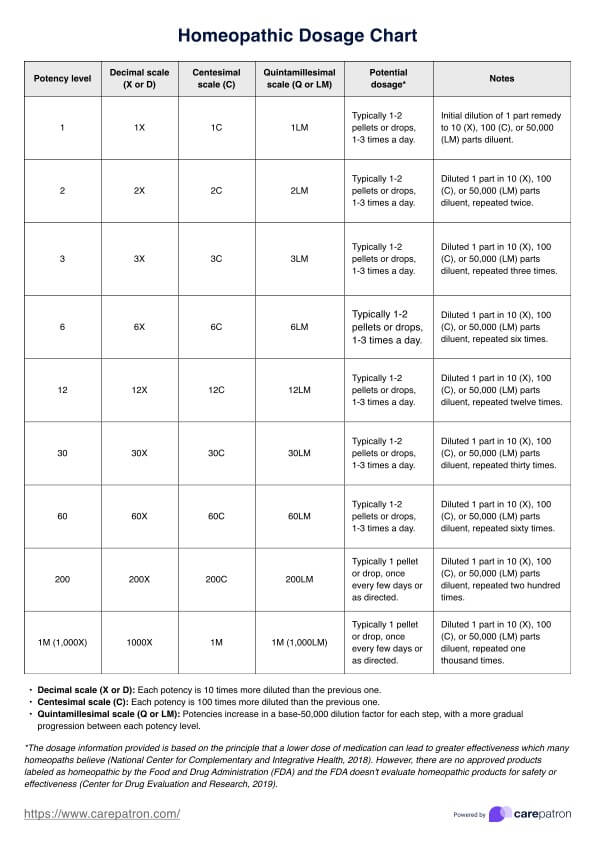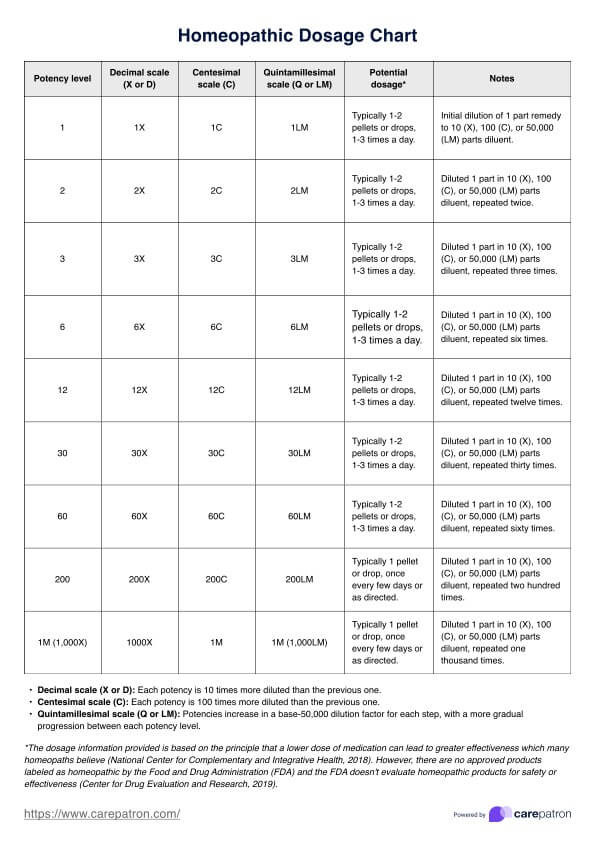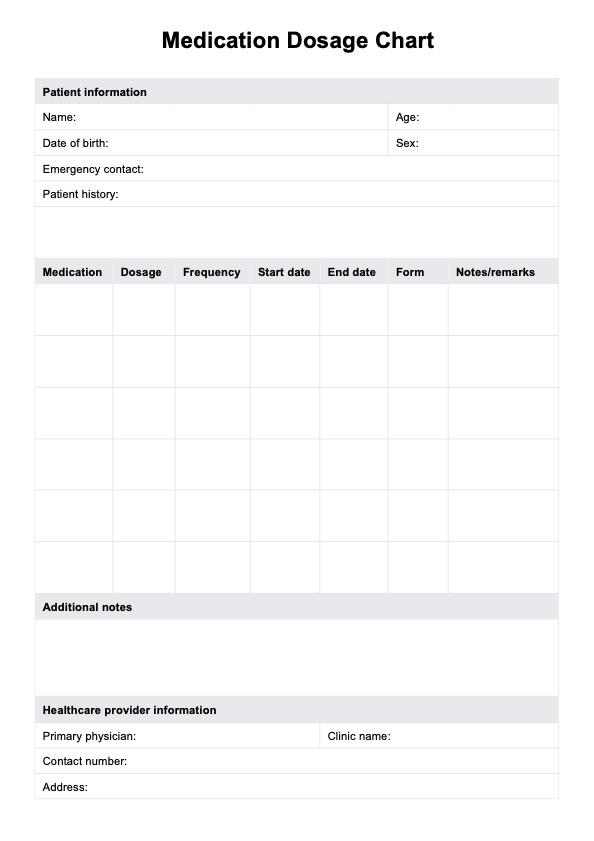Homeopathic Dosage Chart
Access a free Homeopathic Dosage Chart for reference. Learn how to determine the dosage of homeopathic remedies.


What is homeopathy?
Homeopathy was founded in the late 18th century by German physician Samuel Hahnemann. With its unique approach to diagnosis, treatment, and dosage, it has since gained popularity worldwide as a complementary and alternative medicine (CAM).
In his article in the British Journal of Clinical Pharmacology, Ernst (2002) explains that homeopathy is based on two principles. The first principle is known as "like cures like." This concept suggests that patients experiencing specific signs and symptoms can find relief through a homeopathic remedy that produces similar effects when given to healthy individuals. The second principle asserts that homeopathic remedies retain their biological activity even after significant dilution and succussion, remaining effective even when diluted beyond Avogadro's number.
Homeopathy believes that lower potencies of medication can be more effective (National Center for Complementary and Integrative Health, 2018) than a higher potency for a more effective healing response. For example, a medium-potency or low-potency remedy can often be more effective than remedies with higher potencies, depending on the individual's specific symptoms and needs.
The effectiveness of homeopathy is a highly debated topic within the medical community. Grams (2019) argues that homeopathy undermines the scientific method and fuels the troubling rise of post-science and post-truth attitudes, which gradually erode trust in scientific institutions and the integrity of science itself. Similarly, Ernst (2002) asserts that homeopathy cannot be regarded as an evidence-based therapy due to its implausible theories and the absence of rigorous clinical trials to substantiate its claims.
Despite the controversies surrounding homeopathy, it continues to be a popular choice for many individuals seeking alternative or complementary treatment options. Some people believe that a professional homeopath or homeopathic practitioner offers a gentler and more natural approach to healing without the harsh side effects often associated with conventional medicine.
Homeopathic Dosage Chart Template
Homeopathic Dosage Chart Example
What is a Homeopathic Dosage Chart?
A Homeopathic Dosage Chart serves as a valuable reference for practitioners and patients to identify the correct dosage and homeopathic potency of homeopathic remedies. This chart categorizes homeopathic dilutions using three scales:
- Decimal scale (X or D): This scale refers to the number of times the original substance has been diluted and succussed (shaken vigorously). For example, a potency of 6X means that the original substance was diluted six times during the homeopathic preparation.
- Centesimal scale (C): Similar to the decimal scale, this potency scale indicates the number of dilutions and succussions but at a more significant ratio. For instance, a potency of 30C of a homeopathic remedy would indicate that the original substance was diluted and succussed thirty times in succession.
- Quintamillesimal scale (Q or LM): The LM potency scale is a variation of the Centesimal scale. It involves diluting and succussing remedies using a 1:50,000 ratio. This scale tends to be gentler and more suitable for sensitive individuals.
The Homeopathic Dosage Chart also includes the potential dosage of a homeopathic treatment based on dilution and potency and the suggested frequency of administration for homeopathic preparations. It is a crucial tool that can be used as a reference for homeopathic preparations.
However, note that the Food and Drug Administration (FDA) does not regulate the use of homeopathic remedies, and there are no standardized dosing guidelines (Center for Drug Evaluation and Research, 2019). Healthcare professionals should caution patients from self-treating with homeopathic remedies and creating their own dosage plans.
How does our Homeopathic Dosage Chart template work?
Carepatron has created a homeopathic dosage guide template that can be used as a reference for potency levels and potential dosages of remedies based on the X, C, and LM scales.
Step 1: Download the chart
Click "Use Template" to access the template via the Carepatron app. You can also click "Download" to get a PDF version of the Homeopathic Dosage Chart template.
Step 2: Review the information
Read through the homeopathic potency chart to familiarize yourself with the different scales and their corresponding dilutions for homeopathic dosing guidelines. Take note of the potential dosage and frequency of administration for each potency level.
Step 3: Use as a reference
This homeopathy dose chart is meant to be used as a reference tool to assist in selecting and administering homeopathic remedies. However, we do not recommend creating a dosage plan solely based on this chart.
Step 4: Save and share
You can save and print the homeopathic medicine dosage chart for your reference or share it with colleagues who may find it useful. Make sure to tell them that the chart should not be used as a standalone guide for homeopathic dosing.
Examples of homeopathic remedies
A diverse array of remedies is available, each claimed to target specific ailments with distinct indications and uses. Here are some of the most common homeopathic remedies and their applications:
- Arnica montana: This remedy is a cornerstone in homeopathic medicine, renowned for treating physical trauma, bruising, and muscle soreness. It is considered particularly beneficial following surgery, dental work, or any injury that leads to shock and trauma. Arnica promotes faster healing by reducing swelling and pain, making it an indispensable remedy in homeopathic first aid kits.
- Belladonna: Known for its rapid action in acute conditions, Belladonna is said to be most effective in treating sudden, intense symptoms such as high fever, redness, throbbing pain, and inflammation. It is particularly useful in acute infections where the person may experience hot, red skin, a flushed face, and dilated pupils.
- Nux vomica: This remedy is often used for issues arising from lifestyle excesses, such as overeating, excessive caffeine or alcohol consumption, and lack of sleep. It is known to address digestive disturbances, including heartburn, nausea, bloating, and constipation, offering relief to those who feel irritable, chilly, and generally overindulgent.
- Calendula afficinalis: Utilized for its remarkable healing properties, Calendula is applied externally as a cream, ointment, or spray to soothe and heal cuts, scrapes, wounds, and minor burns.
- Pulsatilla: This remedy is suited to gentle, emotional individuals who feel better in the fresh air. It's commonly used for colds with thick, yellow discharge, varicose veins, and menstrual disorders.
- Rhus toxicodendron: Ideal for joint and muscle pain that improves with movement, Rhus Tox is a go-to remedy for conditions like arthritis, back pain, and sprains. It is especially helpful when pain is worse on initial motion but decreases with continued movement.
- Silicea (silica): Silicea is a powerful remedy for pushing out splinters or foreign objects from the skin. It's also used to strengthen weak, brittle nails and hair, and to treat conditions that involve pus formation, like abscesses or infections.
Again, individuals should consult a healthcare professional before trying any homeopathic remedies, especially if they are pregnant or taking other medications. Homeopathic remedies may be used with traditional medical treatments, but patients need to disclose all treatments they are undergoing to ensure no interactions or adverse effects.
Are homeopathic medicines effective?
As mentioned, the effectiveness of homeopathic remedies has long been debated, yet numerous anecdotal reports suggest that many people have found positive results from their use. One potential explanation for this phenomenon is the power of suggestion and belief; much like other forms of alternative medicine, an individual's mindset and trust in a remedy can significantly influence their experience.
Lobera and Rogero-García (2020) emphasize that the scientific presentation of alternative therapies, including homeopathy, through prescription, communication, and marketing, plays a crucial role in shaping public trust. Together, these factors illustrate the complex dynamics involved in the perception and effectiveness of homeopathic treatments.
However, Ernst's (2002) systematic review of systematic reviews on homeopathy reveals insufficient evidence to claim that any specific homeopathic remedy produces clinically significant effects that differ from placebo or outperform other control interventions for any medical condition.
Conversely, some experts argue that there may be genuine physiological responses to homeopathic remedies. The dilution process used in creating these medicines could activate certain biochemical pathways in the body, leading to immune responses or other healing mechanisms.
Bell and Koithan (2012) propose a nanoparticle model for homeopathy, suggesting that this alternative medicine is scientifically plausible and backed by substantial empirical research. Their study indicates that homeopathic remedies exert their biological effects primarily as nanostructures, meaning the tiny particles in these remedies may interact with the body’s cells and tissues, resulting in a physiological response.
Further supporting this idea, a study by van Wijk & Wiegant (2015) investigated how homeopathic remedies affect the human body, specifically through their impact on skin electrical conductivity. In their research, they transitioned a healthy subject to a diseased state using a low dose of toxin before exposing them to either a homeopathic remedy or a placebo. Data from both open (229 points) and blind trials (750 points) demonstrated that homeopathic remedies could indeed influence conductivity. The results revealed an identification accuracy of 85% in open trials compared to 65% in blind trials, with significant conductivity differences between homeopathic and placebo remedies in both trial types. This suggests that the tester's muscle tone might influence remedy selection, further indicating that homeopathy could have a tangible impact on the body's electrical conductivity and, by extension, its physiological effects.
Nevertheless, healthcare professionals and patients alike should exercise caution when considering homeopathy as an alternative treatment. While it may show potential for physiological effects, the lack of scientific evidence and credibility in its principles raises concerns about its safety and efficacy.
References
Bell, I. R., & Koithan, M. (2012). A model for homeopathic remedy effects: Low dose nanoparticles, allostatic cross-adaptation, and time-dependent sensitization in a complex adaptive system. BMC Complementary and Alternative Medicine, 12(1). https://doi.org/10.1186/1472-6882-12-191
Center for Drug Evaluation and Research. (2019). Homeopathic products. U.S. Food and Drug Administration. https://www.fda.gov/drugs/information-drug-class/homeopathic-products
Ernst, E. (2002). A systematic review of systematic reviews of homeopathy. British Journal of Clinical Pharmacology, 54(6), 577–582. https://doi.org/10.1046/j.1365-2125.2002.01699.x
Grams, N. (2019). Homeopathy—where is the science? EMBO Reports, 20(3). https://doi.org/10.15252/embr.201947761
Lobera, J., & Rogero-García, J. (2020). Scientific appearance and homeopathy. Determinants of trust in complementary and alternative medicine. Health Communication, 36(10), 1278–1285. https://doi.org/10.1080/10410236.2020.1750764
National Center for Complementary and Integrative Health. (2018, July). Homeopathy.
van Wijk, R., & Wiegant, F. A. C. (2015). Physiological effects of homeopathic medicines in closed phials – a critical evaluation. Homeopathy, 104(4), 292–294. https://doi.org/10.1016/j.homp.2015.06.001
Commonly asked questions
The dosage for homeopathic remedies typically follows the principle of "less is more." This means that a lower concentration of the active ingredient is believed to have a stronger effect on the body. The specific amount and frequency of dosing will depend on the individual's condition and the recommendations of a qualified homeopath.
The amount of homeopathic medicine to take varies depending on the individual and their specific condition. It is recommended to consult with a licensed homeopath or healthcare professional who can provide personalized dosing instructions.
The dosage of homeopathic medicine often depends on the individual's existing symptoms and their severity. Generally, it is recommended to start with a low potency and gradually increase as necessary, always considering any similar symptoms that may arise. Homeopathy operates on the principle of prescribing remedies tailored to the unique expression of symptoms presented by the patient. As such, patients should practice caution and consult a healthcare professional before taking any homeopathic medicine.











































































































